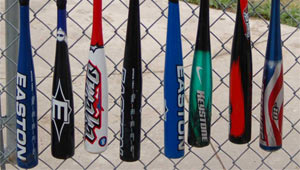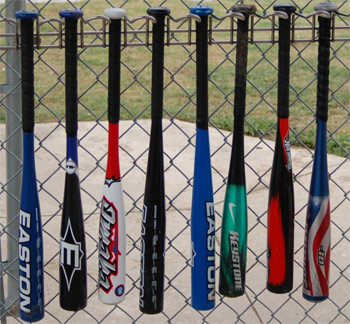Choosing The Right Baseball Bat

One of the most important factors in a young player’s enjoyment of the game is his (or her) success at the plate. Besides proper training in the art and science of hitting a baseball, the bat itself plays a big role. Choosing the right Baseball Bat is crucial. Too many well-meaning but uninformed parents buy their kid a bat that is the wrong length or weight, or both. This adds yet another obstacle to the budding player’s efforts to succeed. The choices include different materials, different barrel sizes, different weights, different lengths, and different models for Tee Ball, Youth Baseball, Senior League Baseball, High School baseball, and College ball.
 As a rule of thumb, we suggest the lightest bat of a given length that you can afford. The high-tech alloys in the lightest bats cost the most, while inexpensive bats made from cheaper aluminum – which requires thicker walls for strength – are heavier. According to Louisville Slugger bat engineer George Manning, “Performance of the bat goes up as the walls are thinned down in aluminum bats. High-strength alloys allow the walls to be thinned while retaining strength needed for durability.”
As a rule of thumb, we suggest the lightest bat of a given length that you can afford. The high-tech alloys in the lightest bats cost the most, while inexpensive bats made from cheaper aluminum – which requires thicker walls for strength – are heavier. According to Louisville Slugger bat engineer George Manning, “Performance of the bat goes up as the walls are thinned down in aluminum bats. High-strength alloys allow the walls to be thinned while retaining strength needed for durability.”
A starting player needs to learn to make contact with the ball and hit close to the “sweet spot” of the bat before performance differences in the bats become an important factor.
“Length-to-weight ratio” is perhaps the most important factor in buying a bat. This is a negative number denoting the amount of ounces the bat weighs less than the amount of inches of its length. For example, a 30-inch bat that weighs 20 ounces is a -10. The greatest differential commonly found is -12 for youth bats. Senior League bats are -7, used in Senior Little League as well as Pony, and -5 is for High School. Some of the mysterious letters and numbers on modern bats indicate the materials with which they’re made. For example, 7046 is a lower-end alloy, usually used in cheaper youth bats.
CU31 is a fairly common alloy, once the hottest stuff, but now used in the mid-range bats. It gave way to the current crop of C405 alloy bats, generally the top-of-the-line in most cases. Easton’s Reflex, Worth’s Copperhead, Louisville Slugger’s Air Attack2, and many DeMarini bats come in C405. (Worth does make lower end Copperheads as well.) Easton also has a more modern C500 alloy, and a SC500 which includes Scandium, an element purportedly used in Russian missile casings for strength and lightness. These pricey alloys comprise the popular Redline and Z-Core series. Bat barrel diameters are usually 2-1/4 inch, 2-5/8 inch, or 2-3/4 inch. The smallest size is required by Little League (up to age 12) as well as some lower divisions of other organizations. Be clear on what limits there might be in your child’s league before buying a bat. The larger barrel diameters decrease length-to-weight ratios due to the increased material to make them. They usually have more ‘pop’ in them and hit the ball harder too.
Worth recently completed a project with a research group to determine the best bat weight for players in youth and adult baseball (see charts). It should be noted that the ideal bat weight for maximum hit ball speed is approximately one ounce heavier than the recommendation. The reason for this is that the research showed there is negligible loss of hit ball speed by reducing bat weight one ounce below the ideal, and the increased bat control with the lighter weight more than compensates. Atlanta Braves’ Chipper Jones recently spoke at a clinic at the ABCA Convention in Atlanta. He was told as a rookie to “swing the heaviest bat you can get around on a 90-mph pitch,” so Chipper practiced in the off-season with a 39 oz. bat. In games, though, he uses a 33 oz. bat, unless he’s facing Curt Schilling, Kevin Brown, or someone else who brings it in the high 90s. Then he drops an ounce and maybe even an inch.
The point is, even a Major League player goes to a lighter bat to maintain bat speed, which is top priority in hitting. So it’s that much more crucial for a young, undeveloped player to have a light enough bat to swing with enough bat speed to hit the ball with some authority. When shopping for a bat, have your child hold it out to his side with the top hand (right hand for right-handed batter). If he cannot hold it straight out for 20 seconds or so without the arm starting to shake and the bat dropping, it’s too heavy.
It’s difficult to get a feel for a bat in a store, and even if you could safely swing it there, it’s very different from swinging at pitched balls hurtling towards you. If you really want to do some research, take your kid to a local batting cage and have him hit with a selection of cage bats available there on loan. You’ll see right away which ones are obviously too small, too big, or too heavy. It’s dialing it in to the exact right inch and ounce that’s tricky. But if you get close, and even if the bat might be an inch too long (remember – a longer bat puts more weight out further from the hands, which in effect makes it heavier to swing than a shorter bat of the same weight), the player can choke up a little. If he needs to choke up more than an inch, however, go to the next inch-size down.
Players over the age of 13, playing in advanced leagues, club ball, or high school, are usually adept enough to figure out the bat that’s best for them, and can borrow teammates’ bats to experiment. It’s the younger guys that need guidance and the right decisions made by mom and dad (or coach) to ensure they’re swinging the right bat for their size, strength, and skill level.
Youth 8-10 Years Old
Player Height / Best Bat Weight:
48 in. 16 oz.
50 in. 16.5 oz.
52 in. 17 oz.
54 in. 17.5 oz.
56 in. 18 oz.
58 in. 18.5 oz.
60 in. 19 oz.
Formula = (Height/4) + 4
Youth 11-12 Years Old
Player Weight / Best Bat Weight:
70 lbs. 18 oz.
80 lbs. 19 oz.
90 lbs. 19.5 oz.
100 lbs. 20 oz.
110 lbs. 20.5 oz.
120 lbs. 21 oz.
130 lbs. 21.5 oz.
140 lbs. 22 oz.
150 lbs. 23 oz.
Formula = (Weight/18) + 14
High School & College
Player Height / Best Bat Weight:
66 in. 27 oz.
68 in. 27.5 oz.
70 in. 28 oz.
72 in. 29 oz.
74 in. 30 oz.
76 in. 30.5 oz.
Formula = Height/3 + 6
Charts courtesy of Worth Inc.

This article is out of date and should be taken down. High school and College players swing -3’s not -5’s. -5’s have not been swung in ages.
Yes, this article is outdated, but instead of taking it down we should update it. If you would like to contribute that would be great!
The article might be outdated, but some of the principles are still the same. Bat control at a younger age regardless of mandated bat drop is definitely key. My son has recently moved to the mandated drop 3 from drop 5 and decided to go with a shorter bar which also decreased weight by an ounce to achieve better bat control. Very informative and a good read. Some things maybe to add would be swing weights determined by MOI (moment of inertia) and how a heavier bat could swing lighter because of the weight distribution.
So my son just started 6th grade and hes playing baseball. He only weighs about 75 lbs. His coach told him to get a 3 lb bat, but when I go to the stire im seeing anything that says 3 lbs. What am I looking for to get the right bat?
3 lb bat makes no sense. Maybe his coach meant to say a -3oz. drop bat? I would clarify with the coach directly if it were me.
Exactly, a 3 pound bat would dent/break with one soft toss hit
Unless its literally just a short metal tube
You do realize that bats are measured in ounces correct? A 3 pound bat would be 48 ounces…
48 oz is about as heavy as what Babe Ruth swung his day…they don’t make a bat heavier than 34-36oz these days. Anyway, he needs a -12 (drop 12) or -10 at the heaviest because he’s a bean pole.
I’d suggest a 16oz, 28 in bat or a 18oz, 30in bat or some variation close to that.
What would a bat -12.5 relate to in ounces?? 16 oz??
Rob – It depends on the length. If a bat is a -12.5 then subtract 12.5 from the length to find the weight. If it is a 33 inch bat, the weight would be 20.5oz.
I’ve been told my son will need a -5 drop bat to play 13u travel. Is this true? since I’m shopping bats and -5 bats are far few and between..I know high school requires -3 drop but I’m thinking going from -10 to a -3 might be a huge difference and transitioning with a -5 drop could be a good thing anyway…
These charts are meaningless. My six year old played in a U7 Coach Pitch league. He was the only kid in the league using a wood bat (he insisted). It was a 28″ and I weighed it at 21.7 oz. He was one of the best hitters in the league.
wood bats aren’t the same as metal-aluminium bats. They probably have different requirements for wood bats making it look heavier.
What’s meaningless is your belief that one specific player, your son, invalidates a chart meant to be used for the average player. Think before you post.
Exactly, Thank you Scott for posting that, you beat me to it. Burnt son.
I have a 10 year old that stands 5’4” and goes 170#. We’ve spent numerous dollars because he’s killing the ball. He plays in the Minor division but just cleared 210 feet fence in a Major field!! He’s denting every bat we buy him! He’s practicing with a 32” wood Rawlings Big Stick but we got him an Easton -8 450 and he dented that too!! I was looking for a heads up on what kind of bat would be somewhat indestructible for him?? Barrel has to be no bigger than 25/8ths inches but need some weight because he’s always hitting to left or left center field,so his timing is on. Please help if you can??
Really wish you would talk wood bat, nobody uses metal bats anymore not counting school ball, most if not all amateur leagues have a wood bat rule due to people being badly injured or even killed by metal bats, its an abomination that needs to be outlawed period. Be that as it may most of us wood bat users can never find any good advice about wood bats, very frustrating. I play in the MSBL it is huge nationwide.
I have never seen one kid using a wood bat in ANY league. I’ve seen countless games of all ages and even coached early teens. Maybe it’s different depending on the area, but in Georgia, I’ve never seen a kid use a wood bat.